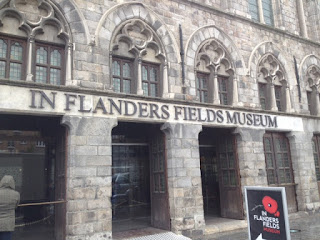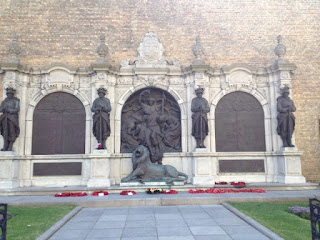“In Flanders Fields the poppies blow, between the crosses,
row on row…”
Every Canadian knows that poem, especially every Guelphite.
It is, unsurprisingly, Guelph’s biggest export to the rest of the country. Guelph
is, after all, home to John McCrae’s birthplace, his high school, and the
Ontario Agricultural College, where he taught for a year while taking time off
from his medical studies at the University of Toronto.
It’s tragic for me to admit, but having grown up in Guelph
and having lived in Guelph for 98% of my life, I felt that John McCrae and his
poem had become mundane. I’ve felt, for a long time, as though the poem had
become just words. Something we recited every Remembrance Day as we listened to
the Last Post and had our moment of silence. As school children we were made to
memorize the poem every November and recite it as a group. One year my class
was chosen to recite the poem to the school over the PA system. We each were
given a line to recite individually. Over the years I began to feel about
Remembrance Day, the same way I felt about Christmas: I just didn’t care
anymore. We’d go through the motions, but it just didn’t mean anything.
In 2012, Remembrance Day happened to fall on a Sunday, and
at the time I was living at the corner of London and Woolwich. We were
experiencing a late Indian Summer that year and it was a beautiful day. I’d
never been to the cenotaph for the ceremonies before, and since I wasn’t
working, I decided to go check it out. I took my dog with me since she’s always
up for an outing. As the cenotaph was just a short distance from where I was
living, we walked. I was surprised at the diversity of the people present, and
I wasn’t the only one who brought their dog. I saw two very big (and very
shaggy) Newfoundlanders who were wearing homemade poppies on their dog collars.
I don’t remember much about the ceremony itself, mostly because I’m a bit
vertically challenged and it was difficult to see, but afterwards everyone
(myself included) placed the poppies we’d been wearing on the cenotaph.
 |
| The Menin Gate in Ypres |
In doing so, I found a bit of a connection that I’d been
missing between myself and what I felt was an intangible concept. I’m not from
a military family. To my knowledge, the last military person was my Dad’s
father, who passed away before I was born. My Mom’s father, whom I did know,
had been denied entry into the army due to an old wrestling injury. The concept
of war is just something I read about in the paper, or see in documentaries. I
have no first hand stories or accounts. In placing my poppy on the cenotaph, I
felt that perhaps I wasn’t so far removed from the Great War as I’d felt for so
long.
 |
| Poppy wreaths |
I started working for the City of Guelph back in March of
this year. My new co-workers and museum staff were already well into their projects
on promoting In Flanders Fields and John McCrae. McCrae House was undergoing
renovations and was preparing for a grand reopening later in the spring. The
Civic Museum was preparing for several new exhibits about the war. Once the
snow had melted, the museum also began preparing the grounds for where the new
statue of John McCrae would soon call home.
Initially, I felt a bit of dread, knowing that once again I
would have John McCrae and his poem foisted upon me. Eventually, however, I
slowly began to feel a sense of pride in the work that we were doing. Guelph
was home to someone special.
The last week of July, I was in Brussels with a friend of
mine. I made the two hour train journey to Ypres (which took three hours, since
I got stuck in Ghent after a missed connection). I’d happened upon an
advertisement for the In Flanders Fields Museum in the April-May edition of
Canada’s History and was determined to go check it out. Almost the moment I
stepped off the train it began raining. I had my jacket, but no umbrella. I
also realized I had no idea where I was going. I’d forgotten to look up the
directions! I navigated the old cobblestone streets towards the city centre. I
knew the museum was somewhere around the main square, and in most old cities,
there’s at least one church in the city centres.
 |
| The main entrance to the museum |
After a five-ish minute walk through the Belgian rain, I
happened upon the museum. I paid my entrance fee of €9,
as well as the extra €2 to climb the bell tower. I walked
up the stairs to the exhibit. In the background you could hear a low rumbling,
as if there was fighting in the distance.
I found the In Flanders Fields museum to be a very unique experience. With your entrance fee, they give you a rubber bracelet that contains a microchip, with which you can access the displays. You have the option at the beginning of the museum to input some information about yourself. Primarily the language of wanted to view the presented information in (English, Dutch, French, or German), your family name, your age, gender, and where you’re from. There are four opportunities throughout the museum to have what they describe as a personal encounter with someone who fought in the war. The computer tries to match you up with someone who is around the same age as you, and from the same part of the world. For a long time I felt that the world wars were this intangible concept, often discussed and debated, but no longer something I could comprehend. Reading these four short biographies made the war somehow more human, more relatable.
| This allows for an interactive experience |
In addition to the personal encounters, the microchip in the
bracelet also allows you to access information about the items contained in the
display cases. Unlike most museums that have little plaques beside each item
with a description, the In Flanders Fields museum had an interactive display
screen on each case. You’d hold your bracelet up to the wifi symbol to access
the information, and you could choose which items to view. If you had input your information at the
beginning, it would automatically default to your preferred language.
 |
| A familiar face |
It took me about two hours to get through the museum. I
wanted to look at everything. I wanted to experience everything. I had come a
very long way, and wasn’t going to waste this opportunity. I left the exhibit
nearly in tears, overwhelmed by emotion. I exited the museum into sunny Belgian skies.
The rain had stopped and the clouds parted. I took the time to wander around
the town a little before heading back to Brussels. Ypres is a beautiful city
and worth visiting, even if you’re not into visiting war museums. It can be a
heavy topic for vacations, after all.
 |
| One of the many war memorials in Belgium |
As I sit here typing this out, I’m watching the 2015 Artist in Residence working on his latest portrait. Greg Denton’s theme is 100 Portraits/100
Poppies: Sitting in Remembrance. Denton's project will create 100 portrait of veterans and military members of the community, as well as those who have been affected by war and loss, and those inspired by John McCrae's poem. All will be wearing a poppy on their lapel, and once all the portraits are together, it will create the allusion of a field of poppies. I am literally surrounded by John McCrae’s work
this year.
In Flanders Fields is turning 100 this year. If you haven’t
already, take a bit of time to appreciate the poem and what it means to you on
a personal level. The poem is more than just words. It represents love and
loss, pain and suffering. But it also represents hope; the hope that someday,
society may be able to resolve conflict without the need to blow everything up.
The Guelph Civic Museum has some excellent exhibits on the First World War. Fighting in Flanders: Gas. Mud. Memory opens to the public August 21 and will
be on display until November 15. Also be sure to check out the new John McCrae
statue that now proudly sits just outside the museum, overlooking the city. It’s
a legacy that I’m proud to share with the world.
 |
| Home at last |



No comments:
Post a Comment